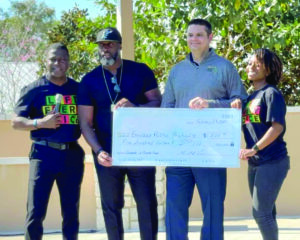Workplace Inequity Worsens for Black Women

Teamwork concept. Three beautiful black women wearing dresses sitting at the table in an office and discussing over project
BLACKPRESSUSA NEWSWIRE — Meanwhile, they remain underrepresented in high-wage fields like tech, law, and executive management—even when they hold the degrees and credentials to qualify.
By Stacy M. Brown
Black Press USA Senior National Correspondent
Black women remain the backbone of the U.S. labor force—working more, earning less, and bearing greater burdens across nearly every sector. Even as the country added 177,000 jobs in April, Black women lost 106,000 positions, the steepest decline of any group. Their unemployment rate jumped to 6.1%, according to the U.S. Bureau of Labor Statistics. But the losses go far deeper than a single month of data. Research shows Black women are not only overrepresented in low-wage industries like care, cleaning, education, and food service—they are also consistently denied advancement and paid significantly less than white male peers, even with the same credentials. In its July 2024 report, the Institute for Women’s Policy Research (IWPR) found Black women working full-time, year-round earned just 69.1 cents for every dollar paid to white men. That figure drops to 49.6 cents in states like Louisiana. “Black women consistently have higher labor force participation rates than other demographics of women,” officials from the National Partnership for Women and Families wrote. Yet those higher participation rates have not translated into pay equity or job security.
The earnings gap grows wider with age. For example, Black women aged 56 to 65 working full-time, year-round, earn just 59.3 cents for every dollar paid to white men in the same age group. Those in leadership roles report disproportionately high dissatisfaction with pay and access to advancement, with 90% of women of color in management saying systemic barriers hinder workplace progress. Additionally, according to a 2022 Health Affairs report, more than one in five Black women in the labor force are in health care—more than any other group. However, nearly two-thirds of them work as licensed practical nurses or aides, and 40% are in long-term care. These roles are among the lowest-paid and highest-risk in the industry, often involving grueling schedules, poor benefits, and unsafe conditions. Beyond health care, the National Employment Law Project found that more than half of Black women work in jobs where they are overrepresented, such as childcare, janitorial work, and food preparation. Meanwhile, they remain underrepresented in high-wage fields like tech, law, and executive management—even when they hold the degrees and credentials to qualify.
In Boston, Charity Wallace, a 37-year-old biotech professional, and Chassity Coston, a 35-year-old middle school principal, both say they’re leaning heavily on community and mental health strategies to cope with workplace challenges. “It’s a constant fight of belonging and really having your girlfriends or your homegirls or my mom and my sister,” Wallace told NBC News. “I complain to them every day about something that’s going on at work. So having that circle of Black women that you can really vent to is important because, again, you cannot let things like this sit. We’ve been silenced for too long.” Limited opportunities for promotion and sponsorship compound the isolation many Black women feel in their workplaces. In 2024, writer Tiffani Lambie described the “invisible struggle for Black women” at work. “The concept of ‘Black Girl Magic’ contributes to the notion that Black women are superheroes,” she wrote. “Although the intent of this movement was to empower and celebrate the uniqueness of Black women, the perception has also put Black women at greater risk of anxiety and depression—conditions that are more chronic and intense in Black women than in others.”
She warned that workplace conditions—marked by fear, lack of support, and erasure—threaten to push more Black women out of leadership and career pipelines. “If left untouched, the number of Black women in leadership and beyond will continue to decline,” Lambie wrote. “It is incumbent on everyone to account for these experiences and create an equitable and safe environment for everyone to succeed.” The Urban Institute recently spoke with a Black woman who transitioned from part-time fast food work to a full-time data entry role after completing a graduate degree. The job offered her better pay, health insurance, and stability. “It gives you a sense of focus and determination,” she said. “Now, I can build my career path.”







